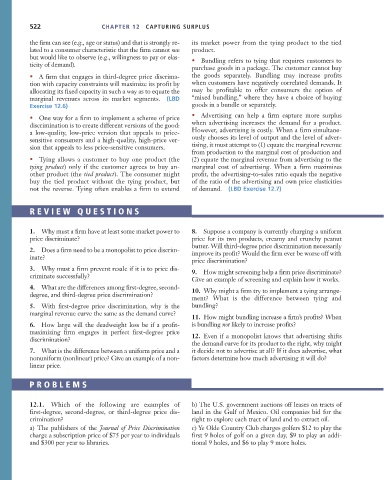Page 548 - Microeconomics, Fourth Edition
P. 548
c12capturingsurplus.qxd 7/22/10 10:41 AM Page 522
522 CHAPTER 12 CAPTURING SURPLUS
the firm can see (e.g., age or status) and that is strongly re- its market power from the tying product to the tied
lated to a consumer characteristic that the firm cannot see product.
but would like to observe (e.g., willingness to pay or elas- • Bundling refers to tying that requires customers to
ticity of demand).
purchase goods in a package. The customer cannot buy
• A firm that engages in third-degree price discrima- the goods separately. Bundling may increase profits
tion with capacity constraints will maximize its profit by when customers have negatively correlated demands. It
allocating its fixed capacity in such a way as to equate the may be profitable to offer consumers the option of
marginal revenues across its market segments. (LBD “mixed bundling,” where they have a choice of buying
Exercise 12.6) goods in a bundle or separately.
• One way for a firm to implement a scheme of price • Advertising can help a firm capture more surplus
discrimination is to create different versions of the good: when advertising increases the demand for a product.
a low-quality, low-price version that appeals to price- However, advertising is costly. When a firm simultane-
sensitive consumers and a high-quality, high-price ver- ously chooses its level of output and the level of adver-
sion that appeals to less price-sensitive consumers. tising, it must attempt to (1) equate the marginal revenue
from production to the marginal cost of production and
• Tying allows a customer to buy one product (the (2) equate the marginal revenue from advertising to the
tying product) only if the customer agrees to buy an- marginal cost of advertising. When a firm maximizes
other product (the tied product). The consumer might profit, the advertising-to-sales ratio equals the negative
buy the tied product without the tying product, but of the ratio of the advertising and own price elasticities
not the reverse. Tying often enables a firm to extend of demand. (LBD Exercise 12.7)
REVIEW QUESTIONS
1. Why must a firm have at least some market power to 8. Suppose a company is currently charging a uniform
price discriminate? price for its two products, creamy and crunchy peanut
butter. Will third-degree price discrimination necessarily
2. Does a firm need to be a monopolist to price discrim- improve its profit? Would the firm ever be worse off with
inate?
price discrimination?
3. Why must a firm prevent resale if it is to price dis- 9. How might screening help a firm price discriminate?
criminate successfully?
Give an example of screening and explain how it works.
4. What are the differences among first-degree, second- 10. Why might a firm try to implement a tying arrange-
degree, and third-degree price discrimination?
ment? What is the difference between tying and
5. With first-degree price discrimination, why is the bundling?
marginal revenue curve the same as the demand curve?
11. How might bundling increase a firm’s profits? When
6. How large will the deadweight loss be if a profit- is bundling not likely to increase profits?
maximizing firm engages in perfect first-degree price
discrimination? 12. Even if a monopolist knows that advertising shifts
the demand curve for its product to the right, why might
7. What is the difference between a uniform price and a it decide not to advertise at all? If it does advertise, what
nonuniform (nonlinear) price? Give an example of a non- factors determine how much advertising it will do?
linear price.
PROBLEMS
12.1. Which of the following are examples of b) The U.S. government auctions off leases on tracts of
first-degree, second-degree, or third-degree price dis- land in the Gulf of Mexico. Oil companies bid for the
crimination? right to explore each tract of land and to extract oil.
a) The publishers of the Journal of Price Discrimination c) Ye Olde Country Club charges golfers $12 to play the
charge a subscription price of $75 per year to individuals first 9 holes of golf on a given day, $9 to play an addi-
and $300 per year to libraries. tional 9 holes, and $6 to play 9 more holes.

